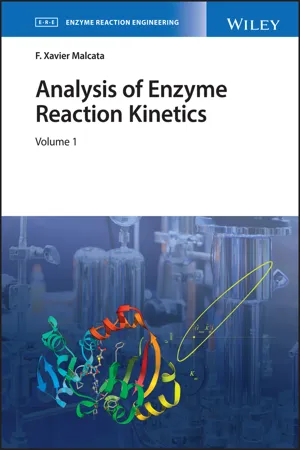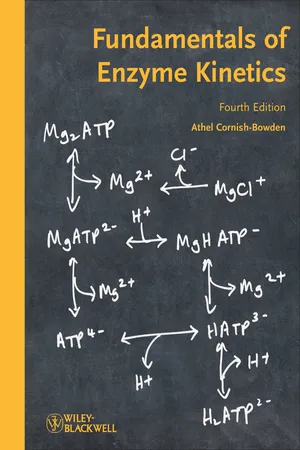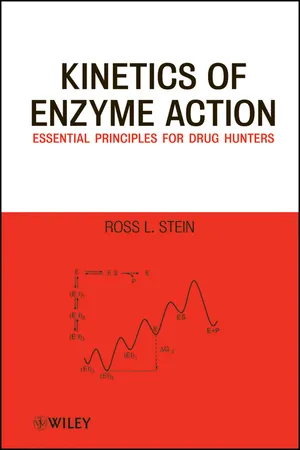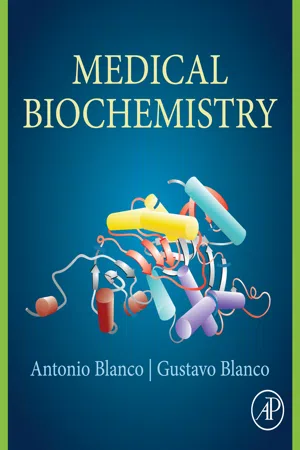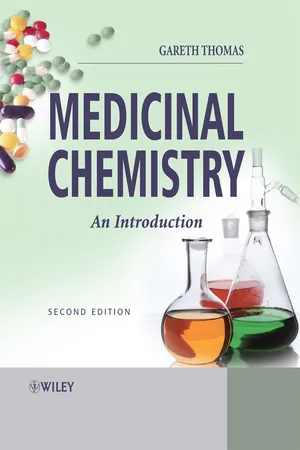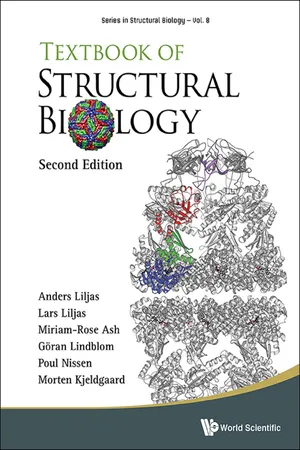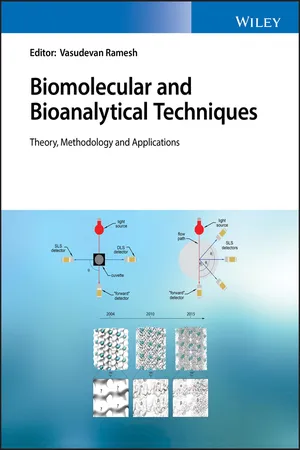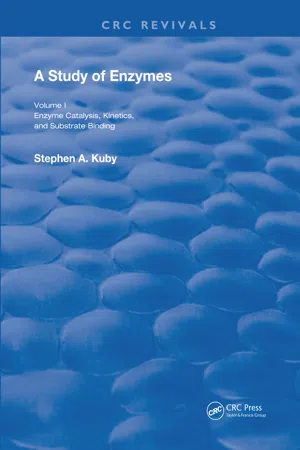Biological Sciences
Enzyme Substrate Complex
The enzyme-substrate complex is a temporary association between an enzyme and its substrate molecule. During this complex formation, the substrate is bound to the active site of the enzyme, allowing for the catalysis of a specific chemical reaction. This interaction facilitates the conversion of the substrate into the product, after which the enzyme is released to catalyze another reaction.
Written by Perlego with AI-assistance
Related key terms
Related key terms
1 of 4
Related key terms
1 of 3
10 Key excerpts on "Enzyme Substrate Complex"
- eBook - ePub
- F. Xavier Malcata(Author)
- 2023(Publication Date)
- Wiley(Publisher)
1 Introduction1.1 Basic Concepts
Enzymes are the functional units of cell metabolism; these globular proteins with catalytic features possess high activity toward their substrates, at mild operating conditions – which makes them particularly attractive to support clean technologies of chemical processing. Because of the decreasing trend in cost of manufacture of enzymes from microbial sources, those biocatalysts are now available for industrial purposes at higher and higher quantities – and with higher and higher purities, at affordable prices. Hence, enzymes have enjoyed a remarkable growth in associated knowledge, owing to their relevant contributions to such widespread activities as brewing, fruit juice clarification, dry and detergent cleaning, and analytical determinations.As catalysts, enzymes bring about increases in the rate of biochemical reactions without undergoing permanent chemical change themselves; however, such an efficiency usually requires interaction between enzyme and substrate molecules via formation of intermediates with chemical identity. On the other hand, the reactions they catalyze are far from instantaneous – yet the time they take to occur depends on the pathway followed by enzymes to accelerate them. Therefore, the usefulness of rate expressions relating the evolution in concentration of substrate(s) with time – based on postulated intermediates, should reflect the best balance between simplicity and accuracy toward bioprocess engineering at large. The first step is obviously reactions encompassing a single substrate – or run at conditions that mimic a single substrate; multisubstrate enzymatic reactions will thus be left for later discussion.Despite its lack of general applicability to enzyme‐catalyzed reactions due to the underlying simplifying assumptions, unisubstrate rate expressions have conquered a status of reference – and are accordingly useful to compare performance between enzymes in general. The (relative) simplicity in mathematical form of the said rate expressions is probably their major asset – coupled to their mutual resemblance, in terms of asymptotic behaviors predicted and underlying chemical meaning of the very few kinetic parameters at stake. To fully grasp their impact and provide a better scientific framework, a historical perspective is put forward – and further refinements are mentioned, for the sake of completeness. - eBook - ePub
- Athel Cornish-Bowden(Author)
- 2013(Publication Date)
- Wiley-Blackwell(Publisher)
Later, however, Boeker developed a systematic approach that allows many of the mechanisms important in the study of enzymes to be handled in the same way. By this time, however, less efficient initial-rate methods of analyzing the same mechanisms had become so widespread that her work has had less impact than it merited. An example of an application may be found, however, in a study by Schiller and co-workers of variants of aspartate transaminase. In recent years the main work on the analysis of time courses of enzyme-catalyzed reactions has been that of Duggleby and co-workers, whose papers should be consulted for more information. The article of Goudar and co-workers is of particular interest as it describes how to express the progress of a reaction as a function of time: it is more usual (but much less convenient for curve-fitting purposes) to express time as a function of the progress, as in equation 2.45. Summary of Chapter 2 The enzyme–substrate complex is a feature of all modern ideas of enzyme mechanisms. The enzyme–substrate complex is sometimes said to exist in equilibrium with the free enzyme and substrate molecules, but it is more accurate to say that there is a steady state in which the rate of formation is balanced by the rate of breakdown to products. Both assumptions lead to a kinetic equation of the same form, the Michaelis–Menten equation. The Michaelis–Menten equation defines a function in which the rate is proportional to the substrate concentration at very low concentrations, but flattens out as the system approaches saturation, approaching a value known as the limiting rate and symbolized as V - eBook - ePub
Kinetics of Enzyme Action
Essential Principles for Drug Hunters
- Ross L. Stein(Author)
- 2011(Publication Date)
- Wiley(Publisher)
.3.2 KINETIC CONSEQUENCES OF AN ENZYME : SUBSTRATE COMPLEXWe saw in Chapter 2 that in the opening years of the twentieth century, enzymologists posited that enzyme-catalyzed reactions proceed with the initial formation of a binary complex of enzyme and substrate. In this section, we examine the thermodynamics of E : S complex formation and the kinetic partitioning of the complex once it is formed.3.2.1 Thermodynamics of Saturation KineticsA kinetic feature of all enzyme-catalyzed reactions is the observation of so-called “saturation kinetics,” in which initial velocities increase with increasing substrate concentration until a limiting velocity is reached, at which pointvobecomes [S ]o independent. As we learned in Chapter 2, this behavior is a consequence of the intermediacy of the E : S complex. Here, we examine the underlying thermodynamics of the formation E : S from E and S .During the steady state of an enzyme-catalyzed reaction for which rapid equilibrium conditions obtain (see Fig. 2.3), the concentrations of E and E : S are equilibrium concentrations and are thus determined by the ratio [S ]o /KS, which of course equals [ES ]/[E ]. When [S ]o /KS1, enzyme exists almost entirely as free enzyme, whereas when [S ]o /KS1, enzyme is captured by substrate and exists predominantly as the E : S complex. Figure 3.2 illustrates these concepts as free energy diagrams.Figure 3.2. Thermodynamics of the formation of the Michaelis complex. The free energy diagrams illustrate how substrate concentration determines ΔG for dissociation of E : S.In the diagrams of Figure 3.2 we assume aKsof 1 µM and akcvalue of 0.1 s−1 . The diagram on the left illustrates the kinetic situation when [S ]o /KS1. From this diagram we see that the reversible formation of E : S from E is an endothermic reaction, requiring an input of energy. In contrast, the diagram on the right shows the exothermic formation of E : S that results under the condition [S ]o /KS - eBook - ePub
- Antonio Blanco, Gustavo Blanco(Authors)
- 2017(Publication Date)
- Academic Press(Publisher)
e ). Thus, more molecules reach the intermediate or transition state, and the chemical transformation is accelerated. Enzymes greatly increase the reaction rate and, like any catalyst, they do not modify the net energy change or the equilibrium constant of the reaction.During the course of the reaction, an enzyme actually attaches to the substrates forming a transient complex. Eventual modifications of the molecule during such binding are ephemeral, meaning the enzyme appears unchanged at the end of catalysis.If an enzyme E catalyzes the transformation of substrate S to product P, enzyme and substrate form a complex ES, which then dissociates into enzyme and product:Formation of the ES complex, initially proposed on theoretical grounds, has been demonstrated experimentally. In the course of the reaction, the enzyme effectively binds to the substrate. Finally, the enzyme is unchanged, and can again bind to another substrate molecule. This explains why very small amounts of enzyme greatly accelerate the reaction rate. The same molecule is reused many times.Active site
To form the ES complex, the substrate is attached to a defined place on the enzyme. This region of the molecule has received the names of active site , active center , catalytic site , or substrate site . This is where the catalytic action of the enzyme is accomplished (Fig. 8.1 ).Figure 8.1 Schematic representation of an enzymatic reaction.The active site has binding and catalytic sites. The substrate is placed in the binding site in such a manner that the place that will be modified in the substrate is positioned exactly at the catalytic site. Both the binding and catalytic actions require a highly specific three-dimensional conformation at the level of the active site, where the side chains of amino acid residues play an essential role. For example, the reactive side chains of cysteine, glutamate, aspartate, lysine, arginine, histidine, serine, threonine, and hydrophobic residues play an important role in substrate binding. - eBook - ePub
Medicinal Chemistry
An Introduction
- Gareth Thomas(Author)
- 2011(Publication Date)
- Wiley(Publisher)
Enzyme Nomenclature .This text uses trivial names as they are usually easier to pronounce. In addition, some letter abbreviations will also be used. 9.3 Active sites and catalytic actionThe reactant(s) whose reaction is catalysed by an enzyme is known as the substrate (s ). All naturally occurring enzyme-controlled processes can be regarded as equilibrium processes. However, under body conditions many processes appear only to proceed in one direction because as soon as the products are formed they are either immediately used as the substrates of a subsequent enzymecatalysed reaction or physically removed from the vicinity of the enzyme.In its simplest form, the catalytic action of enzymes is believed to depend on the substrate or substrates binding to the surface of the enzyme. This binding usually occurs on a specific part of the enzyme known as its active site . Once the substrate (S) or substrates are bound to the surface of the enzyme (E) a reaction takes place and the products (P) are formed and released whilst the enzyme is recycled into the system.The mechanism by which enzymes act is probably more sophisticated than that suggested by this simple active site model.Active sites are usually visualised as pockets, clefts or indentations in the surface of the enzyme. These physical features are the result of the conformations of the protein’s peptide chain. Consequently, the amino acid residues forming the site can be located some distance apart in the peptide chain but are brought together by the folding of the peptide chain. For example, the amino acid residues that form the active site of lactate dehydrogenase occupy positions 101, 171 and 195 in the peptide chain. The amino acid residues most often involved in forming active sites are serine, histidine, arginine, cysteine, lysine, aspartic acid and glutamic acid. - eBook - ePub
Biomass, Biofuels, Biochemicals
Advances in Enzyme Catalysis and Technologies
- Sudhir P. Singh, Ashok Pandey, Reeta Rani Singhania, Christian Larroche, Zhi Li(Authors)
- 2020(Publication Date)
- Elsevier(Publisher)
[11] .1.3 What is enzyme catalysis?
1.3.1 Basics of enzyme catalysis
Enzyme catalysis plays a vital role in the metabolism of all the living organisms. Enzymatic reactions are like chemical reactions, which result in the product, and the free energy change (ΔG ) during this process is negative. However, the rate of reaction depends on another factor, known as activation energy (EA). If the ΔG is favorable, but still the need of high EA leads to slower progression of the reaction. The biological reaction is required to be catalyzed in the fractions of a second [12] . The slower biochemical changes are made faster (1010 –1020 ) by using the enzymatic actions, without which a reaction may take millions of years to complete [13] . The rate of free energy change, during the progression of enzymatic catalysis, is represented by a bell-shaped curve. The peak in the graph represents transition state (TS), which is an intermediate of the substrate (S) and the product (P). In a reaction, the difference between the free energy of the substrate and the transition state determines the rate of reaction and is referred to as EA. All the catalysts, chemical or biological, are supposed to minimize the EA of a reaction. However, enzymatic reactions are relatively complex as they require substrate binding and forms more than one stable intermediate.1.3.2 Historical overview of enzyme catalysis theory
The first theory of enzyme catalysis was the “lock and key” model proposed by Emil Fischer, which states that the substrate fits in the enzymes like a key fits into the lock [2] . This was later modified by Koshland’s “induced-fit” theory, proposing that substrate does not fit to the enzyme perfectly, but performs a subtle conformational change in the enzyme’s active site. Later on, Koshland’s induced-fit theory was extended by Eyring’s in 1935 as “transition-state” theory [3] , and further by Pauling’s “transition-state stabilization” theory in 1946. Transition-state theory narrates that an enzyme binds preferentially to the transition-state intermediate rather than a substrate or product. This reduces the free energy of the transition state and thereby reduces the energy of activation, achieving an accelerated reaction. Adding to this, the motion of the catalytic residues has been noted to be lesser than the binding residues. However, at the same time, side chains display similar motion [14] - eBook - ePub
- Anders Liljas, Lars Liljas;Miriam-Rose Ash;G?ran Lindblom;Poul Nissen;Morten Kjeldgaard(Authors)
- 2016(Publication Date)
- WSPC(Publisher)
8
Enzymes
Enzymes are proteins that catalyze biochemical reactions without being consumed, and are able to perform the same reaction over and over again. They have a wide range of catalytic properties and are classified on that basis (hydrolases, ligases, reductases, oxidases and so on).Enzymes are usually large molecules, but only a small fraction of the amino acid residues participate in the catalysis. The area of an enzyme where the binding of the substrate(s) and the catalysis occurs is called the active site. The active sites are frequently located in some sort of depression or cavity in the structure of the enzyme. Sometimes cofactors (like metal ions) or coenzymes (like NADH) are bound in the active site and participate in the reaction.Many enzymes are highly specific for their substrates. This is generated by complementarities in shape of the substrate and the active site. The complementarity may also include the charge, polarity and hydrophobicity relationship between substrate and active site. Due to this complementarity enzymes are often highly stereospecific, substrates with the wrong hand may not be able to bind. Different models have been used to describe the interaction between enzyme and substrate. An early description is the “lock and key model” which illustrates the complementarity but not how the enzyme may function.Enzymes are flexible molecules like all proteins. The dynamics involve atomic oscillations, side chain reorientation and movements of main chain or of whole domains. This dynamic character is essential for enzyme activity. During binding and catalysis residues of the active site or large parts of the enzymes can undergo conformational changes just like the substrate going through chemical changes. One model that emphasizes the conformational changes of enzyme as well as substrate is called “induced fit” (Figure 8.1 - eBook - ePub
- Stefan Lutz, Uwe Theo Bornscheuer(Authors)
- 2012(Publication Date)
- Wiley-VCH(Publisher)
Chapter 13
Assessing and Exploiting the Persistence of Substrate Ambiguity in Modern Protein Catalysts
Kevin K. Desai and Brian G. Miller13.1 Quantitative Description of Enzyme Specificity
A widely accepted tenet of biochemistry is that protein catalysts possess a remarkable level of specificity for their physiological substrates. Indeed, enzymes encounter a surfeit of potential substrates during their normal cellular lifespan, many of which possess overlapping functional groups. Common moieties such as phosphoryl groups, carboxylate side chains and hydroxyl substituents have the potential to complicate molecular recognition inside an active site. Despite the structural and electrostatic similarities of the multitude of metabolites found within a cell, enzymes are capable of selecting from this pool a single substrate for chemical transformation. In so doing, protein catalysts often recognize single atom differences between individual substrates. The discriminatory power of enzymes, which is a hallmark of biological catalysis, is rarely observed in the small-molecule catalytic counterparts that synthetic chemists employ on a daily basis. As a result, chemists and engineers have begun to explore the possibility that Nature’s own catalyst of choice could be subverted for the needs of humankind.The ability of enzymes to catalyze the chemical transformations of two competing substrates can be represented by the simple reaction schemes and corresponding rate equations shown below:(13.1)In Equation 13.1 , E is the enzyme, S1 and S2 are competing substrates, and P1 and P2 are the products of the enzymatic transformations of S1 and S2 , respectively. Similarly, and - eBook - ePub
Biomolecular and Bioanalytical Techniques
Theory, Methodology and Applications
- Vasudevan Ramesh, Vasudevan Ramesh(Authors)
- 2019(Publication Date)
- Wiley(Publisher)
two molecules of A combining to form some product). The reaction initially proceeds rapidly, but falls significantly as the concentration of A approaches zero. Enzyme kinetics have a greater level of complications. These arise because the enzyme catalyst is a highly complex molecule and undergoes structural changes on a very rapid (nanosecond to microsecond) timescale. The enzyme reaction usually occurs on a microsecond to second timescale and includes many steps (including substrate binding, the formation of intermediates and the release of products). Consequently, the process by which the enzyme speeds up the reaction must be considered to understand the nature of the catalytic process and the relevant kinetic parameters. The nature of enzyme catalysis is to provide a reaction pathway with a lower free energy barrier than the uncatalysed reaction (Figure 9.3). Most enzyme‐catalysed reactions take place at a very slow rate in the absence of catalysis. All reactions must pass through one or more transition state(s) that are maxima in free energy. The rate of the reaction will be determined by the proportion of substrate molecules that are able to access this state. In order to access the enzyme‐catalysed intermediate state, the substrate must first bind to the enzyme. As binding of substrate to the enzyme is usually a fast, reversible event, the rate of these reactions is far too rapid to be determined except with specialist instruments designed to collect rate data on millisecond timescales (see Advanced Methods, Section 9.6). Figure 9.3 Schematic of enzyme catalysis. The uncatalysed reaction (red) has to overcome a large free energy barrier to reach the transition state (TS). A simple example enzyme catalysed reaction (blue) provides a reaction route at a lower free energy. The free energy barrier is lower, allowing more molecules to react - eBook - ePub
A Study of Enzymes
Enzyme Catalysts, Kinetics, and Substrate Binding
- Stephen A. Kuby(Author)
- 2019(Publication Date)
- CRC Press(Publisher)
Chapter 1Historical Introduction, Theories of Enzyme Catalysis, and some Elementary Considerations of Enzyme Kinetics
I. Introduction
Any understanding of other branches of biochemistry ultimately depends, to a large degree, on some knowledge of the nature, properties (both physical and chemical), and actions of the enzymes, which in turn are responsible for the rate of chemical changes which occur in all living organisms. The myriad of reactions and chemical pathways involved in the intermediary metabolism of protein, fat, and carbohydrate and the intricate chemical reactions concerned with the energetics of the cell are mediated through protein catalysts. Many physiological processes such as muscular contraction, blood clotting, excretion, de-toxication, digestion, etc. are intimately linked with the chemistry of the cell, which invariably hinge on enzymatically catalyzed reactions. To quote Dixon,9 “Life depends on a complex network of chemical reactions brought about by specific enzymes, and any modification of the enzyme pattern may have far-reaching consequences for the living organism …”Enzymes are biocatalysts and as such their function is to influence the rates of chemical reactions. If they act as true catalysts, not the chemical equilibria; they may increase the rate of a particular chemical reaction, but ideally they do not influence the final equilibrium concentrations of reactants and products. However, in several notable cases where investigations were made under conditions where the enzyme concentration was not catalytic, but on the contrary, stoichiometric with respect to the substrate, the final state of the system was shown to be influenced by the enzyme protein concentration. Thus, the enzyme molecule exerts its effective catalytic function by participating directly in the reaction as if it were a reactant. In general, however, where concentrations of enzymes are employed which are several orders of magnitude below that of the substrate(s), the enzyme approaches a true catalyst in nature, and, under these conditions, influences only the rates of chemical reactions and not the final equilibrium state.
Index pages curate the most relevant extracts from our library of academic textbooks. They’ve been created using an in-house natural language model (NLM), each adding context and meaning to key research topics.
Explore more topic indexes
Explore more topic indexes
1 of 6
Explore more topic indexes
1 of 4
